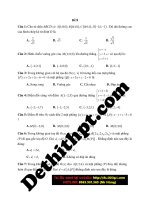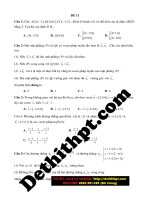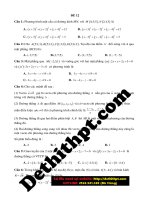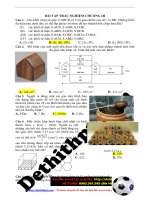Đề 36 image marked image marked
Bạn đang xem bản rút gọn của tài liệu. Xem và tải ngay bản đầy đủ của tài liệu tại đây (1.7 MB, 7 trang )
Exercise 36:
Read the following passage and mark the letter A, B, C or D to indicate the correct answer to each
of the questions.
Cholera, a highly infectious disease, has resulted in millions of deaths time after time over centuries.
It is caused by the bacterium Vibrio cholera, first isolated by Robert Koch in 1883.
The organism enters the body through the digestive tract when contaminated food or water is
ingested.The bacteria multiply in the digestive tract and establish infection. As they die, they release a
potent toxin that leads to severe diarrhea and vomiting. This results in extreme dehydration, muscle
cramps, kidney failure, collapse, and sometimes death. If the disease is treated promptly, death is less
likely.
Đăng ký file Word tại link sau
/>
In many countries, a common source of the organism is raw or poorly cooked seafood taken from
contaminated waters. The disease is especially prevalent after a natural disaster or other destruction that
results in a lack of fresh water. Sewer systems fail, and waste travels into rivers or streams; piped water is
not available so people must take their drinking and cooking water from rivers or streams. Because people
frequently develop communities along waterways, the disease can be spread easily from one community
to the next community downstream, resulting in serious epidemics.
QUESTION
Question 1: The word "infectious" in the first sentence is closest in meaning to _______.
A. communicable
B. severe
C. isolated
D. common
Trang 1
Question 2: According to the passage, cholera is caused by __________.
A. a virus
B. a bacterium
C. kidney failure
D. dehydration
Question 3: All of the following are probably causes of infection except ________.
A. eating food cooked with contaminated water
B. eating undercooked seafood
C. eating overcooked pork
D. eating raw oysters
Question 4: What is the logical order of the events leading to the illness?
A. Sanitary system fails, so fresh water is unavailable; disaster occurs; people drink the water;
contaminated water flows into waterways.
B. Disaster occurs; sanitary system fails, so fresh water is unavailable; people drink the water;
contaminated water flows into waterways.
C. Disaster occurs; contaminated water flows into waterways; sanitary system fails, so fresh water is
unavailable; people drink the water.
D. Contaminated water flows into waterways; disaster occurs; sanitary system fails, so fresh water is
unavailable; people drink the water.
Question 5: According to the passage, what is a symptom of the infection?
A. Release of a toxin by the bacteria.
B. Regurgitation.
C. Overeating.
D. Epidemics.
Question 6: Which of the following would be an appropriate title for this passage?
A. Dysentery and Its Effects
B. Water Purification Systems and Their Importance
C. Results of War and Natural Disasters
D. The Causes and Effects of Cholera
Question 7: The word "prevalent" in the third paragraph is closest in meaning to _____.
A. dangerous
B. commonplace
C. unusual
D. organized
Question 8: According to the passage, cholera _________.
Trang 2
A. is easily passed from one person to another
B. is not a real threat
C. is no more dangerous than the common cold
D. cannot be passed from one to another by casual contact
Question 9: What can you infer from the passage?
A. Careful cooking and hygiene practices can reduce the chance of getting the disease.
B. Water mixed with other substances will not pass the disease.
C. The respiratory system is the most common area of entrance.
D. Kidney disease is the most common cause of the illness.
Question 10: The word "epidemics" at the end of the passage is closest in meaning to ____.
A. studies
B. vaccines
C. bacteria
D. plagues
GIẢI CHI TIẾT
Question 1: The word "infectious" in the first sentence is closest
in meaning to ____________.
A. communicable
B. severe
C. isolated
D. common
Dịch nghĩa: Từ "infectious" ở câu đầu tiên gần
nghĩa nhất với ______.
A. có thể truyền nhiễm
B. nghiêm trọng
C. bị tách biệt
D. phổ biến
Giải thích: Ta có: (be) infectious = (be) communicable: dễ lây nhiễm
Question 2: According to the passage, cholera is caused by __________.
A. a virus
B. a bacterium
C. kidney failure
Dịch nghĩa: Theo đoạn văn, tiêu chảy bị gây ra bởi __________
A. một loại virus
B. một loại vi khuẩn
C. suy thận
D. dehydration
.
D. sự mất nước
Giải thích: Ta có dòng 2: "lt is caused by the bacterium Vibrio Cholerea..."-"Nó được gây ra bởi loại vi
khuẩn Vibrio Cholerea
Question 3: All of the following are probably causes of infection except ________.
Trang 3
A. eating food cooked with contaminated water
B. eating undercooked seafood
C. eating overcooked pork
D. eating raw oysters
Dịch nghĩa: Tất cả những cái sau là nguyên nhân tiềm năng của việc truyền nhiễm ngoại trừ________.
A. ăn thức ăn được nấu với nước ô nhiễm
B. ăn hải sản không nấu chín
C. ăn đồ ăn bị nấu quá chín
D. ăn hàu sống
Giải thích: Ta thấy tác giả nói về nguyên nhân dẫn đến dịch tả: "In many countries, a common source of
the or the organism is raw or poorly cooked seafood taken from contaminated waters" -"Ở nhiều nước,
một nguồn tế bào nhiễm độc thường gặp là hải sản sống hoặc chưa được nấu chín được đánh bất từ nguồn
nước nhiễm bẩn." Đồ ăn nấu quá chín không phải là nguyên nhân gây bệnh.
Question 4: What is the logical order of the events leading to the illness?
A. Sanitary system fails, so fresh water is unavailable; disaster occurs; people drink the water;
contaminated water flows into waterways.
B. Disaster occurs; sanitary system fails, so fresh water is unavailable; people drink the water;
contaminated water flows into waterways.
C. Disaster occurs; contaminated water flows into waterways; sanitary system fails, so fresh water
is unavailable; people drink the water.
D. Contaminated water flows into waterways; disaster occurs; sanitary system fails, so fresh water is
unavailable; people drink the water.
Dịch nghĩa: Đâu là thứ tự logic của những sự kiện dẫn đến dịch bệnh?
A. hệ thống thoát nước hỏng, nước sạch không có sẵn, thảm họa xảy ra, mọi người uống nước, nước bẩn
chảy vào đường nước
B. thảm họa xảy ra, hệ thống nước hỏng, vì vậy nước sạch không có sẵn, mọi người uống nước, nước bẩn
chảy vào đường nước
C. thảm họa xảy ra, nước bẩn chảy vào dòng nước, hệ thống nước hỏng, vì thế nước sạch không có
sẵn, mọi người uống nước
D. nước sạch chảy vào đường nước, thảm họa xảy ra, hệ thống nước bị hỏng, nước sạch không có sẵn,
mọi người uống nước
Giải thích: Ta đọc câu 2, đoạn cuối: "The disease is especially prevalent after a natural disaster or other
destruction that results in a lack of water. Sewer system fails, and waste travels into rivers or streams,
piped water is not available so people must take their drinking and cooking from rivers or streams"-"Căn
bệnh đặc biệt phổ biến sau một thảm họa thiên nhiên hay những sự tàn phá khác dẫn đến sự thiếu nước.
Trang 4
Hệ thống thoát nước bị hỏng, chất thải đi vào sông hoặc suối, nước lọc không có sẵn nên mọi người phải
lấy nước uống và ăn từ sông hoặc suối."
Đáp án C.
Question 5: According to the passage, what is a symptom of the infection?
A. Release of a toxin by the bacteria.
B. Regurgitation.
C. Overeating.
D. Epidemics.
Dịch nghĩa: Theo bài viết, triệu chứng của sự truyền nhiễm là gì?
A. một sự phát ra của chất độc bởi vi khuẩn
B. triệu chứng nôn
C. ăn quá nhiều
D. bệnh dịch
Giải thích: Đọc đoạn 1 ta có: "As they die, they release a potent toxin that leads to severe diarrhea and
vomitting"-"Khi chúng chết, chúng phát ra một chất độc mạnh có thể dẫn đến tiêu chảy nghiêm trọng và
nôn"
Regurgitation = vomitting: triệu chứng nôn
Question 6: Which of the following would be an appropriate title for this passage?
A. Dysentery and Its Effects
B. Water Purification Systems and Their Importance
C. Results of War and Natural Disasters
D. The Causes and Effects of Cholera
Dịch nghĩa: Cái nào sau đây là tiêu đề phù hợp cho bài viết?
A. Bệnh lỵ và hậu quả của nó
B. Hệ thống lọc nước và tầm quan trọng của chúng
C. Hậu quả chiến tranh và những thảm họa thiên nhiên
D. Nguyên nhân và hậu quả của dịch tả
Giải thích: Bài viết tập trung nói về tác động của dịch tả và nguyên nhân của nó.
Question 7: The word "prevalent" in the third paragraph is closest in meaning to ____.
A. dangerous
B. commonplace
C. unusual
D. organized
Dịch nghĩa: Từ "prevalent" ở đoạn 3 gần nghĩa nhất với _________.
A. nguy hiểm
B. thường xảy ra
C. bất thường
D. có tổ chức
Giải thích: Ta có: (be) prevalent = (be) commonplace: thường xảy ra
Trang 5
Question 8: According to the passage, cholera _________.
A. is easily passed from one person to another
B. is not a real threat
C. is no more dangerous than the common cold
D. cannot be passed from one to another by casual contact
Dịch nghĩa: Theo bài viết, dịch tả ________.
A. có thể dễ dàng truyền từ người này sang người khác
B. không phải là một mối đe dọa thật sự
C. chỉ nguy hiểm như cúm thường
D. không thể truyền từ người này qua người khác bằng con đường thông thường
Giải thích: Ta thấy câu cuối bài viết: "Because people frequently develop communities along waterways,
the disease can be spread easily from one community to the next community downstream, resulting in
serious epidemics"-"Bởi vì mọi người thường tạo khu vực sinh sống gần nguồn nước, căn bệnh có thể
được truyền đi dễ dàng từ khu vực dân cư này đến khu vực dân cư khác, gây nên dịch bệnh nghiêm
trọng."
Question 9: What can you infer from the passage?
A. Careful cooking and hygiene practices can reduce the chance of getting the disease.
B. Water mixed with other substances will not pass the disease.
C. The respiratory system is the most common area of entrance.
D. Kidney disease is the most common cause of the illness.
Dịch nghĩa: Điều gì có thể được rút ra từ bài viết?
A. Nấu ăn cẩn thận và vệ sinh có thể giảm thiểu khả năng nhiễm bệnh
B. Nước nhiễm những chất khác sẽ không truyền bệnh
C. Đường ruột là khu vực đường nhiễm bệnh thường gặp nhất
D. Bệnh thận là nguyên nhân chính của căn bệnh
Giải thích: Đọc bài ta thấy nguyên nhân chính của dịch bệnh là "raw or poorly cooked seafood taken
from contaminated waters"-"hải sản sống hoặc nấu không chín đánh bắt từ nguồn nước nhiễm
bẩn" nấu ăn cẩn thận và vệ sinh có thể giảm thiểu khả năng nhiễm bệnh
Question 10: The word "epidemics" at the end of the passage is closest in meaning to _____.
A. studies
B. vaccines
C. bacteria
D. plagues
Dịch nghĩa: Từ "epidemics" ở cuối bài viết gần nghĩa nhất với _______.
Trang 6
A. nghiên cứu
B. vắc xin
c. vi khuẩn
D. bệnh dịch
Giải thích: Ta có: epidemics = plague: dịch bệnh, bệnh truyền nhiễm
DỊCH BÀI
Dịch tả, một căn bệnh truyền nhiễm đã gây ra hàng triệu cái chết qua nhiều thế kỉ. Nó bị gây ra bởi
loại vi khuẩn Vibro cholerea, được tách ra lần đầu tiên bởi Robert Koch năm 1883.
Vi sinh vật xâm nhập vào cơ thể thông qua hệ thống tiêu hóa khi thức ăn hay nước nhiễm bẩn được
tiêu hóa. Con vi khuẩn phân chia trong ống tiêu hóa và tạo nên sự nhiễm dịch. Khi chúng chết, chúng phát
ra một chất độc mạnh có thể dẫn đến tiêu chảy nghiêm trọng và nôn. Điều này dẫn đến mất nước nghiêm
trọng, co rút cơ, suy thận, đột quỵ và đôi khi là tử vong. Nếu căn bệnh được chữa trị kịp thời, tử vong sẽ ít
có nguy cơ hơn.
Ở nhiều nước, một nguồn tế bào nhiễm độc thường gặp là hải sản
sống hoặc chưa được nấu chín được đánh bắt từ nguồn nước nhiễm
bẩn. Căn bệnh này đặc biệt phổ biến sau một thảm họa thiên nhiên hay
những sự tàn phá khác, dẫn đến sự thiếu nước. Hệ thống thoát nước bị
hỏng, chất thải đi vào sông hoặc suối, nước được lọc không có sẵn nên
mọi người phải lấy nước uống và nước ăn từ sông hoặc suối. Bởi vì
cộng đồng thường tạo khu vực sinh sống gần nguồn nước, căn bệnh có
thể được truyền đi dễ dàng từ khu vực dân cư này đến khu vực dân cư
khác, gây nên dịch bệnh nghiêm trọng.
Trang 7









